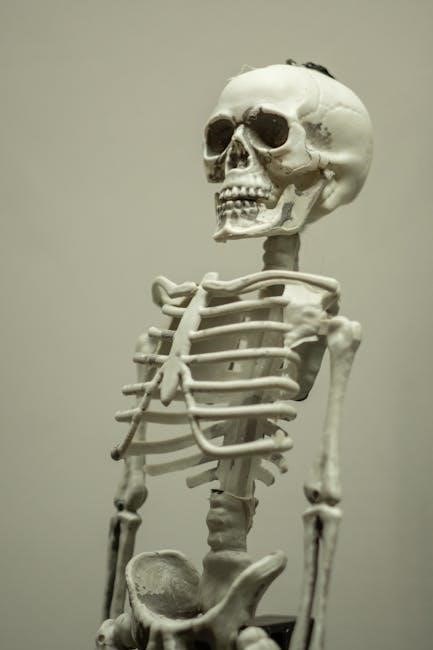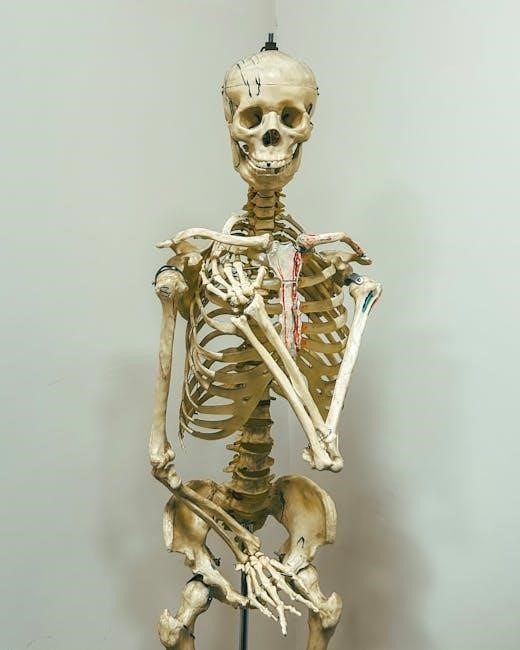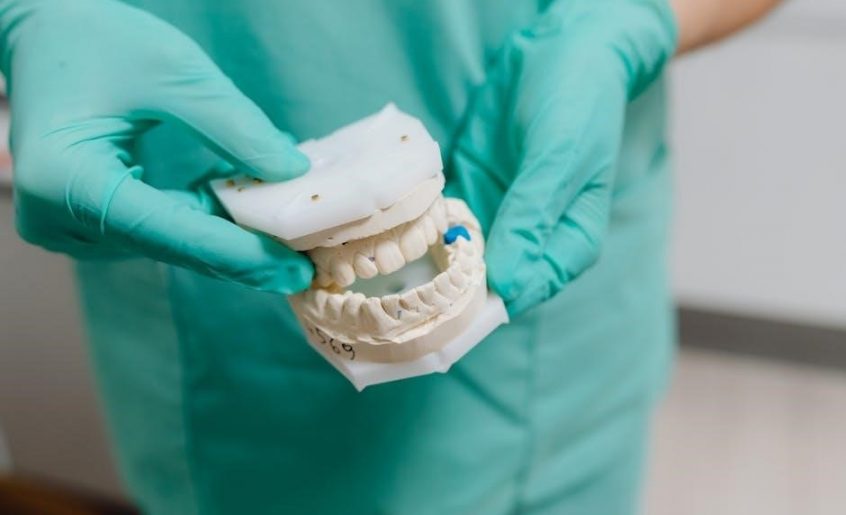The Anatomy Trains concept, developed by Thomas Myers, explores the interconnectedness of fascial networks in the body, revealing how fascia forms continuous myofascial chains.
What Are Anatomy Trains?
Anatomy Trains are myofascial meridians that illustrate the interconnectedness of fascia and muscles, forming continuous chains across the body. These trains highlight how fascia links muscles, bones, and organs into functional units, enabling coordinated movement and stability. Developed by Thomas Myers, this concept challenges traditional anatomy by showing how fascial networks create integrated systems rather than isolated structures. The trains provide a map for understanding how tension or dysfunction in one area can affect others, offering a holistic approach for therapists and movement practitioners. This framework aids in diagnosis and treatment by tracing patterns of strain and compensation, ultimately enhancing movement efficiency and reducing pain.
Historical Background and Development
The Anatomy Trains concept was developed by Thomas Myers, drawing inspiration from earlier anatomists like Raymond Dart and Ida Rolf. First introduced in his 2001 book Anatomy Trains, the idea of myofascial meridians revolutionized understanding of fascia’s role in movement. The concept has since evolved, with the second edition in 2009 and the third in 2014, incorporating new research and applications. Myers’ work built on the idea that fascia forms interconnected chains, enabling holistic approaches to therapy and movement. This framework has been further expanded to include applications in Pilates, horse anatomy, and beyond, solidifying its place in modern anatomy and therapy practices.
Key Contributors to the Concept
Thomas Myers is the primary developer of the Anatomy Trains concept, introducing the idea of myofascial meridians in his seminal work. Karin Gurtner, founder of Art of Motion, expanded the concept through Anatomy Trains in Motion, adapting it for movement therapists. Other contributors include Lou Benson and Michael Morrison, who supported Myers’ early work and enriched the framework through their teachings. Their collective efforts have made Anatomy Trains a cornerstone in manual and movement therapies, influencing diverse fields like Pilates and equine anatomy. These contributors have ensured the concept remains dynamic, evolving with new research and applications in modern therapy and movement practices.

Myofascial Meridians Explained
Myofascial meridians are continuous networks of fascia connecting muscles, creating interconnected movement chains that influence posture, mobility, and overall bodily function, as detailed in Anatomy Trains literature.

The Superficial Back Line
The Superficial Back Line (SBL) is one of the primary myofascial meridians in the Anatomy Trains concept, running from the plantar surface of the feet up to the head. It plays a crucial role in posture, movement, and overall structural integrity. This line includes key structures such as the plantar fascia, Achilles tendon, hamstrings, sacrotuberous ligament, erector spinae, and scalp fascia. The SBL acts as a posterior tensional network, influencing gait, balance, and upright posture. Dysfunction in this line can lead to issues like lower back pain, limited mobility, or poor posture. Therapists often target the SBL to restore alignment and reduce tension, emphasizing its importance in both assessment and treatment strategies.
The Front Line
The Front Line is a critical myofascial meridian in the Anatomy Trains system, extending from the top of the feet to the head, traversing the anterior (front) surface of the body. It includes structures such as the tibialis anterior, quadriceps, rectus abdominis, pectoralis major, sternocleidomastoid, and scalp fascia. This line is essential for movements like kicking, reaching, and maintaining upright posture. It also plays a role in respiratory and digestive functions. Imbalances in the Front Line can lead to issues such as rounded shoulders, neck pain, or difficulties in flexion. Therapists often address this line to restore balance and improve anterior-posterior coordination, enhancing both posture and movement efficiency.
The Lateral Line
The Lateral Line is a myofascial meridian that runs along the outer edge of the body, from the peroneal muscles of the lower leg up to the neck. It includes structures like the peroneals, iliotibial (IT) band, obliques, and lateral neck muscles. This line is crucial for lateral movements, balance, and stability, particularly during activities like walking or single-leg stance. It also supports the body’s ability to adapt to uneven surfaces and rotational forces. Dysfunction in the Lateral Line can lead to issues such as knee pain, poor balance, or difficulty with side-bending movements. Therapists often target this line to restore lateral stability and improve overall movement efficiency.
The Spiral Line

The Spiral Line is a myofascial meridian that wraps around the body in a diagonal pattern, connecting the right arch of the foot to the left shoulder and vice versa. It includes muscles such as the peroneals, iliotibial (IT) band, tensor fasciae latae (TFL), obliques, and rhomboids. This line is essential for diagonal and rotational movements, such as walking, running, or throwing. It plays a key role in transferring forces between the upper and lower body, enabling efficient movement. Dysfunction in the Spiral Line can lead to issues like knee pain, hip misalignment, or shoulder tension. Therapists often address this line to restore balanced movement and reduce pain associated with rotational activities.
The Arm Lines
The Arm Lines are myofascial meridians that connect the arms to the trunk, playing a crucial role in movements involving the upper body. They include muscles like the pectoralis major, latissimus dorsi, and rhomboids. These lines facilitate actions such as pushing, pulling, and overhead movements. The Arm Lines are divided into sections, including the Front Arm Line, Back Arm Line, and Spiral Arm Line, each with distinct functions. Dysfunction in these lines can lead to shoulder or wrist pain, often related to repetitive strain or poor posture. Therapists use techniques like soft tissue work and stretching to restore balance and improve mobility in the Arm Lines, enhancing overall upper body functionality and reducing discomfort.
The Functional Line
The Functional Line is a diagonal myofascial network that connects the shoulder region to the opposite leg, facilitating rotational movements and maintaining balance. It includes muscles such as the quadratus lumborum, tensor fasciae latae, and iliotibial band. This line is essential for activities like walking, running, and twisting, as it transfers forces between the upper and lower body. Dysfunction in the Functional Line can lead to issues like hip or shoulder misalignment, affecting athletic performance and daily mobility. Therapists often target this line to restore proper movement patterns and reduce tension, enhancing overall functional efficiency and reducing the risk of injury.
The Deep Front Line
The Deep Front Line is the innermost fascial network, running along the body’s anterior aspect, from the feet to the head. It includes the inner legs, pelvis, diaphragm, and neck, playing a critical role in posture, respiration, and movement. This line stabilizes and supports the body’s core, enabling efficient transfer of forces during activities. Dysfunction here can lead to issues like chronic pain or respiratory limitations. Therapists often target this line to restore balance and improve mobility, addressing deep-seated tension and enhancing overall structural integrity. Its role in integrating the body’s segments makes it vital for maintaining proper alignment and facilitating fluid, coordinated movement patterns.

Applications of Anatomy Trains in Therapy
The concept integrates fascial connections, enabling effective treatment approaches for pain, movement dysfunction, and injury prevention, offering practical tools for therapists to enhance client outcomes.
Manual Therapy Approaches
Manual therapy approaches based on the Anatomy Trains concept focus on the interconnected fascial web, allowing practitioners to address pain and dysfunction at a distance from the symptom site. By tracing myofascial chains, therapists can apply targeted techniques to release tension in the fascia, improving mobility and reducing discomfort. These methods often involve soft tissue manipulation, joint mobilization, and fascial unwinding. The concept emphasizes treating the body as a whole, rather than isolating individual muscles or joints. This holistic approach promotes structural integration and restores balance to the fascial network, enhancing overall movement and function. Anatomy Trains provides a map for effective, evidence-based manual therapy interventions.
Movement and Exercise Therapy
Movement and exercise therapy rooted in the Anatomy Trains concept focuses on enhancing mobility and strength by engaging the body’s fascial network. By understanding the interconnected myofascial chains, practitioners design exercises that target specific lines, improving posture, balance, and movement efficiency. Techniques such as Pilates-evolved movements and functional exercises align with the fascial anatomy, promoting fluidity and reducing tension. This approach also emphasizes mindful movement to restore fascial balance and prevent injuries. Karin Gurtner’s Anatomy Trains in Motion program exemplifies this, offering dynamic exercises that integrate the body’s fascial connections. These practices empower individuals to move with greater ease and coordination, fostering long-term structural health and well-being.
Sports Performance and Injury Prevention
The Anatomy Trains concept significantly enhances sports performance and injury prevention by mapping myofascial connections, enabling athletes to optimize movement patterns. By understanding the body’s fascial networks, such as the Spiral Line, practitioners can identify and address imbalances that hinder performance or increase injury risk. Targeted exercises and manual therapies improve flexibility, strength, and coordination, while reducing fascial tension. This approach also aids in recovery by restoring fascial integrity post-injury. Coaches and therapists use these insights to design training programs that align with the body’s natural anatomy, ultimately enhancing athletic efficiency and durability. This holistic view of movement supports peak performance and long-term injury resilience.
Anatomy Trains continues to evolve, with emerging research deepening understanding of fascia’s role. Future directions include advanced therapies, integrating new technologies, and expanding applications in diverse fields.
The Role of Fascia in Modern Anatomy
Fascia, once overlooked, is now recognized as a vital connective tissue, forming continuous networks that support movement and structure. Its role in modern anatomy is transformative, revealing how it interlinks muscles, organs, and systems. The Anatomy Trains concept, developed by Thomas Myers, highlights fascia as a web of myofascial meridians, challenging traditional views of isolated muscles. This understanding has revolutionized therapies, offering a holistic approach to treatment and movement. Fascia’s dynamic, adaptable nature is central to modern anatomical studies, emphasizing its importance in maintaining body-wide coordination and resilience.
Emerging Research and Developments
Recent studies have expanded the understanding of fascial networks, validating the Anatomy Trains concept through anatomical dissections and functional assessments. Research highlights the role of fascia in movement efficiency and injury recovery. Advanced imaging techniques now visualize fascial continuity, supporting Myers’ myofascial meridian model. These findings are integrated into updated editions of Anatomy Trains resources, including charts and educational materials. Such developments bridge theory with practical applications, enhancing therapeutic approaches and movement training. Ongoing investigations continue to refine this model, ensuring it remains a cornerstone in modern anatomy and therapy.
Practical Implications for Therapists and Practitioners
The Anatomy Trains concept offers therapists and practitioners a functional framework to address fascial connections in treatment. By tracing myofascial meridians, professionals can identify distant sources of dysfunction, enabling targeted interventions. This approach enhances manual therapy techniques, movement exercises, and injury rehabilitation. Practitioners can apply strategies like fascial release and structural integration to restore balance. The model also informs exercise programs, improving posture, mobility, and sports performance. For movement therapists, resources like Anatomy Trains in Motion provide practical tools to integrate fascial awareness into training. This holistic perspective bridges anatomy and function, empowering therapists to deliver more effective, comprehensive care.
